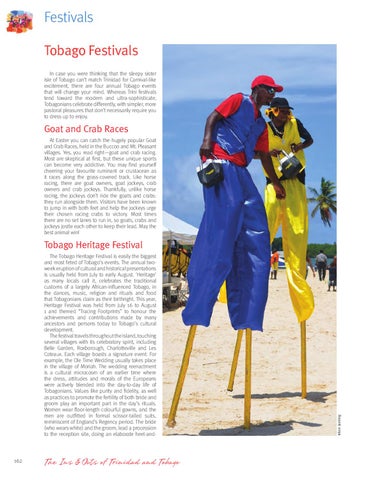Festivals Tobago Festivals In case you were thinking that the sleepy sister isle of Tobago can’t match Trinidad for Carnival-like excitement, there are four annual Tobago events that will change your mind. Whereas Trini festivals tend toward the modern and ultra-sophisticate, Tobagonians celebrate differently, with simpler, more pastoral pleasures that don’t necessarily require you to dress up to enjoy.
Goat and Crab Races At Easter you can catch the hugely popular Goat and Crab Races, held in the Buccoo and Mt. Pleasant villages. Yes, you read right—goat and crab racing. Most are skeptical at first, but these unique sports can become very addictive. You may find yourself cheering your favourite ruminant or crustacean as it races along the grass-covered track. Like horse racing, there are goat owners, goat jockeys, crab owners and crab jockeys. Thankfully, unlike horse racing, the jockeys don’t ride the goats and crabs: they run alongside them. Visitors have been known to jump in with both feet and help the jockeys urge their chosen racing crabs to victory. Most times there are no set lanes to run in, so goats, crabs and jockeys jostle each other to keep their lead. May the best animal win!
The Tobago Heritage Festival is easily the biggest and most feted of Tobago’s events. The annual twoweek eruption of cultural and historical presentations is usually held from July to early August. ‘Heritage’ as many locals call it, celebrates the traditional customs of a largely African-influenced Tobago, in the dances, music, religion and rituals and food that Tobagonians claim as their birthright. This year, Heritage Festival was held from July 16 to August 1 and themed “Tracing Footprints” to honour the achievements and contributions made by many ancestors and persons today to Tobago’s cultural development. The festival travels throughout the island, touching several villages with its celebratory spirit, including Belle Garden, Roxborough, Charlotteville and Les Coteaux. Each village boasts a signature event. For example, the Ole Time Wedding usually takes place in the village of Moriah. The wedding reenactment is a cultural microcosm of an earlier time where the dress, attitudes and morals of the Europeans were actively blended into the day-to-day life of Tobagonians. Values like purity and fidelity, as well as practices to promote the fertility of both bride and groom play an important part in the day’s rituals. Women wear floor-length colourful gowns, and the men are outfitted in formal scissor-tailed suits, reminiscent of England’s Regency period. The bride (who wears white) and the groom, lead a procession to the reception site, doing an elaborate heel-and-
162
The Ins & Outs of Trinidad and Tobago
Inken Janning
Tobago Heritage Festival
